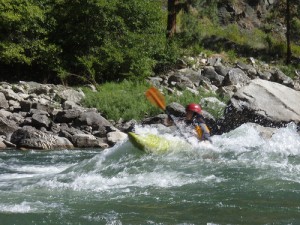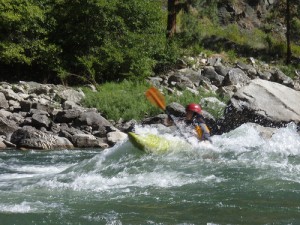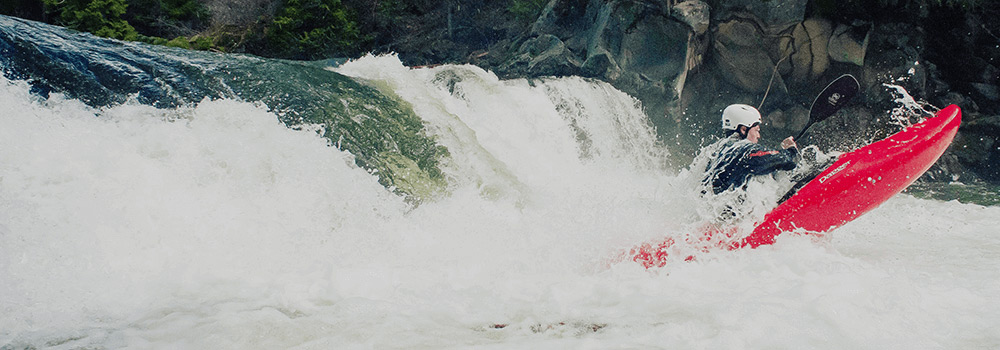I’ve been fortunate enough to paddle some of the bigger rivers in the world including the White Nile in Africa, the Slave River in the Northwest Territories, the Ottawa, the Grand Canyon, the Salmon and I highly recommend the big water experience. To paddlers who learn to kayak on low volume rivers big water can feel intimidating and unpredictable, but for someone who learns on big water the boils, the huge waves and whirlpools feel normal and fun. It’s all in where you learn and what type of rivers you start with. Inspired by the learning curve of the awesome ladies on our latest Girls at Play Main Salmon trip who were paddling big water for the first time, I’ve decided to put together my top 7 tips for learning to kayak big water successfully.

Tip #1
Remember that you have a lot of room to maneuver in big water. One of the reasons why I feel so comfortable in big water is because to me it’s like paddling a big highway. Most of the time the ‘V’s at the entrance of rapids are bigger so you have more room to set up for your moves. This is especially true in class III and IV big water. There is less margin for error in Class V big water as with all class V. Having said that…
Tip #2
The water may be more powerful than it looks so you need to commit to your moves and paddle aggressively. This is especially true if you have to make a lateral move from left to right or right to left to punch through a reactionary wave or avoid a hole. Since you do have a highway to start you can give yourself even more room to get that lateral momentum going. Paddle harder than you think you need to when first starting to paddle big water and make your moves earlier.
Tip #3
When you paddle big water you’re going to have to punch through big waves and wave holes so be aggressive about it. Make sure that you’re paddling strong and not freezing up in the middle of wave trains. Waves are less likely to flip you over if you’re padding and maintaining a speed that is as fast or faster than the current. Stay focused on your paddling not on your nerves.
Tips #4
Paddle through boils with speed. Boils can be the most disconcerting part of paddling big water because they even bubble [6069507359_f513799a1c] up in flatwater! The best way to deal with boils is to get speed and paddle through them. As you get more comfortable with boils you’ll be able to use your edges to stabilize better as you paddle through and you’ll be able to slow down and even use the boils to play!

Tip #5
Take paddle strokes as you’re moving up a wave. This will give you momentum up and over the peak. Then be ready to do it again in the next wave. Not only is this good technique, it’s also a lot of fun! As you get more comfortable in wave trains you’ll be able to relax more, keep your hips looser and take fewer strokes when needed. The tops of waves are also great places to take a look downstream to see what’s coming. It’s your highest point so practice looking around from the top.
Tiip #6
If you swim in big water be as self sufficient and aggressive as you can. If you paddle whitewater you know about the ‘feet up/safe swimmer position.’ The safe swimmer position on your back with your feet pointed downstream in front of you is important for shallow, rocky rivers. In big water you want to be more pro-active, especially if you know where to swim. Keep a hold of your boat and paddle if possible because they can get swept away quickly in the powerful water — especially the paddle. When you have the opportunity to swim into an eddy or toward a friend who can help swim aggressively. The eddy lines are bigger and swirlier so they are going to take more energy to get across.
Tip #7
The water is deep so take your time setting up for your roll and try as many combat rolls as you can before bailing. One of the big advantages of learning to paddle in big water is that you can hang out upside down much longer without running into rocks. And if you do swim you’re not bouncing off of rocks which makes it easier to swim aggressively. On our Main Salmon trip I witnessed some big shifts in paddlers from not wanting to hang upside at all to getting impressive combat rolls. Everyone likes that!!
I hope these tips are helpful on your journey to paddling bigger water. Enjoy and see you on the river!
These are my tips for learning to kayak in big water.

